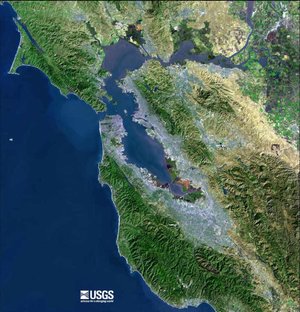San Francisco Bay
|
|
Wpdms_usgs_photo_san_francisco_bay.jpg
The San Francisco Bay is a shallow, productive estuary in which water draining approximately forty percent of California, flowing in the Sacramento and San Joaquin rivers from the Sierra Nevada mountains, enters the Pacific Ocean. Technically, the Sacramento River flows into Suisun Bay, which flows through the Carquinez Strait to meet with the Napa River at the entrance to San Pablo Bay, which connects at its south end to San Francisco Bay, although the entire group of interconnected bays are often referred to as "the San Francisco Bay."
San Francisco Bay is located in the US state of California, surrounded by a contiguous region known as the San Francisco Bay Area, dominated by the big cities San Francisco, Oakland, and San Jose.
| Contents |
Size
The Bay covers somewhere between 400[1] (http://www.sfmuseum.org/hist9/mcgloin.html) and 1600[2] (http://response.restoration.noaa.gov/cpr/watershed/sanfrancisco/sfb_html/sfbenv.html) square miles, depending on which sub-bays (such as San Pablo Bay), estuaries, wetlands, and so on are included in the measurement. The main part of the Bay measures 3 to 12 miles (5 to 20 km) wide east-to-west and somewhere between 48 mi (77 km)1 and 60 mi (97 km)2 north-to-south. One difficulty in obtaining accurate measurements is that the wetlands and inlets of the bay have been gradually and deliberately filled in, changing the Bay's size since the mid-1800s by as much as one third or even more. Recently, large areas of wetlands have been restored, further confusing the issue of the Bay's size.
Despite its value as a waterway and harbor, the many thousands of acres (several km²) of marshy wetlands forming the edges of the bay were considered for many years to be wasted space. As a result, soil excavated for building projects or dredged from channels was often dumped onto the wetlands and into other parts of the bay as landfill. From the mid-1800s through the late 1900s, more than a third of the original bay was filled and often built on. The deep, damp soil in these areas is subject to liquefaction during earthquakes, and most of the major damage close to the Bay in the Loma Prieta earthquake of 1989 occurred to structures on these areas. In the 1990s, the San Francisco International Airport proposed filling in hundreds more acres (km²) to extend its overcrowded international runways in exchange for purchasing other parts of the bay and converting them back to wetlands. The idea was, and remains, controversial.
Role in California settlement
This famous bay was the epicenter of American settlement in the Far West during the 19th century. From the 1820s onward, American presidents and expansionists coveted the bay as a great natural harbor in the Pacific. After many failed efforts to buy the bay and varying areas around it, the US Navy and Army seized the region from Mexico during the Mexican-American War (1845-1848). During the California gold rush of 1848-1850s, San Francisco Bay instantly became one of the world's greatest seaports, dominating shipping and transportation in the American West until the last years of the nineteenth century. The bay's regional importance became paramount when in 1869 the transcontinental railroad located its western terminus in Oakland. San Francisco Bay continues to support some of the densest industrial production and urban settlement in the United States. The San Francisco Bay Area is the American West's second-largest urban area with approximately 8 million residents.
San_fran_bay.jpg
Ecology
Despite its urban and industrial character, San Francisco Bay and the Sacramento-San Joaquin Delta remain perhaps California's most important ecological habitats. California's Dungeness crab, Pacific halibut, and Pacific salmon fisheries rely on the bay as a nursery. The few remaining salt marshes now represent most of California's remaining salt marsh, supporting a number of endangered species and providing key ecosystem services such as filtering pollutants and sediments from the rivers. Most famously, the bay is a key link in the Pacific flyway. Millions of waterfowl annually use the bay shallows as a refuge. SF Bay provided the nation's first wildlife refuge, Oakland's artificial Lake Merritt (constructed in the 1860s) and America's first urban National Wildlife Refuge, the San Francisco Bay National Wildlife Refuge (1972).
Tellingly, much of the SFBNWR consists of salt evaporation ponds purchased or leased from Leslie Salt Company and its successor, Cargill Corporation. These salt ponds produce salt for a variety of industrial purposes, including chlorine bleach and plastics manufacture, as well as supporting dense populations of brine shrimp, and therefore serving as feeding areas for waterfowl. In 2003, California and Cargill entered one of the largest private land purchases in American history, with the state and federal governments paying about $200 million for 16,000 acres (65 km²) of salt ponds in the south bay. SFBNWR and state biologists hope to restore some of the recently purchased ponds as tidal wetlands.
Miscellaneous
San Francisco Bay is spanned by five bridges: the Golden Gate Bridge (which was the largest suspension bridge ever built at the time of its construction), the Richmond-San Rafael Bridge, the San Francisco-Oakland Bay Bridge, the Hayward-San Mateo Bridge and the Dumbarton Bridge.
The southern part of the San Francisco Peninsula including the city of San Jose is known as the Silicon Valley for its high concentration of high-tech, semiconductor and computer-related industry.
The San Francisco Bay is a mecca for sailors, due to consistent strong winds (Beaufort force 6 is common on summer afternoons) and protection from large open ocean swells. Yachting and Yacht racing are popular pastimes and the San Francisco Bay area is home to many of the world's top sailors.
References
- 1. 1999 Grolier Multimedia Encyclopedia.
- 2. 1988 Encyclopedia Britannica.
External links
- Barging In - A Short History of Liveaboards on the Bay (http://www.baycrossings.com/Archives/2001/07_August/barging_in.htm)de:Bucht von San Francisco
eo:Golfo de San-Francisko nl:Baai van San Francisco ja:サンフランシスコ湾

